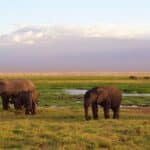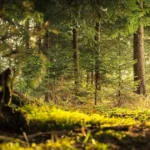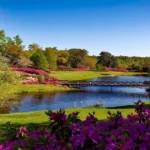Plants play a crucial role in our ecosystems and everyday lives. They provide oxygen, food, and medicine, and they support countless forms of life. Without plants, the earth would be barren and inhospitable.
Plants are classified into various groups based on their characteristics. Two significant groups are gymnosperms and angiosperms. Gymnosperms include conifers like pine and spruce, while angiosperms encompass flowering plants like roses and apple trees. Each group has unique features and adaptations.
This article aims at understanding the difference between gymnosperms and angiosperms. By exploring their distinct characteristics and roles, we can better appreciate the diversity and complexity of the plant kingdom.
What are Gymnosperms?
Gymnosperms are a group of seed-producing plants that include conifers, cycads, ginkgo, and gnetophytes. The term “gymnosperm” means “naked seeds,” which refers to their unenclosed seeds that develop on the surface of scales or leaves, often in cones. Unlike angiosperms, which have seeds enclosed in fruit, gymnosperm seeds are exposed.
One characteristic of gymnosperms is their cone-bearing nature. Cones are their reproductive structures, with male cones producing pollen and female cones housing the seeds. Most gymnosperms are evergreen, retaining their leaves throughout the year. These leaves are usually needle-like or scale-like, which helps them conserve water and survive in harsh climates.
Gymnosperms have a long evolutionary history, dating back over 300 million years to the late Paleozoic era. They were among the first seed plants to evolve, providing them with a significant evolutionary advantage over spore-producing plants like ferns. Gymnosperms dominated the world’s flora during the Mesozoic era, which is often called the “Age of Conifers.”
Common examples of gymnosperms include pine trees, firs, cycads, and ginkgo. Pine trees (genus Pinus) are found in many parts of the world and are known for their long needles and woody cones. Firs (genus Abies) are also widespread and often used as Christmas trees.
Cycads are ancient plants with a palm-like appearance, found mainly in tropical and subtropical regions. Ginkgo (Ginkgo biloba) is a unique gymnosperm with fan-shaped leaves, native to China and often used in traditional medicine.
What are Angiosperms?
Angiosperms are a group of seed-producing plants known as flowering plants. The term “angiosperm” means “enclosed seeds,” referring to their seeds developing inside fruits. This group includes a vast array of plants, from small flowers to large trees, making them the most diverse plant group on earth.
One key characteristic of angiosperms is their ability to produce flowers. Flowers are their reproductive structures, attracting pollinators such as bees and butterflies.
Another distinctive feature is their seeds enclosed within fruits. This enclosure protects the seeds and aids in their dispersal. Angiosperms can be deciduous, shedding leaves seasonally, or evergreen, retaining leaves year-round.
Angiosperms have a rich evolutionary history, emerging around 140 million years ago during the Cretaceous period. They rapidly diversified and became the dominant plant group, surpassing gymnosperms in variety and number.
This evolutionary success is attributed to their efficient reproductive strategies and ability to adapt to different environments.
Common examples of angiosperms include roses, apple trees, grasses, and orchids. Roses (genus Rosa) are popular for their beautiful and fragrant flowers. Apple trees (Malus domestica) are cultivated worldwide for their fruit.
Grasses (family Poaceae) are crucial for ecosystems and agriculture, providing food and habitat. Orchids (family Orchidaceae) are known for their intricate and diverse flower structures, thriving in various habitats, especially tropical regions.
Also Read: Overview of Plant and Animal Diversity
Key Differences Between Gymnosperms and Angiosperms
| Aspect | Gymnosperms | Angiosperms |
| Seed Enclosure | Naked seeds exposed on the surface of cone | Seeds enclosed within fruits |
| Reproductive Structure | Cones | Flowers |
| Leaf Structure | Needle-like or scale-like leaves | Broad Leaves |
| Vascular System | Tracheids (less efficient water transport) | Vessels (more efficient water transport) |
| Pollination & Fertilization | Mainly wind pollination; simple fertilization process | Diverse pollination methods; complex fertilization process |
| Diversity & Distribution | Less diverse; mostly in temperate and boreal regions | Highly diverse; found in various habitats worldwide |
Seed Enclosure: Gymnosperms have naked seeds that are not enclosed within any fruit, while angiosperms produce seeds that are enclosed within fruits, which helps in seed protection and dispersal.
Reproductive Structures: Gymnosperms reproduce through cones, with male cones producing pollen and female cones containing ovules. Angiosperms reproduce through flowers, which can be either unisexual or bisexual, containing both male (stamens) and female (carpels) reproductive organs.
Leaf Structure: Gymnosperms typically have needle-like or scale-like leaves that are adapted to reduce water loss, which is beneficial in colder and drier environments. Angiosperms usually have broad leaves that are more efficient in photosynthesis.
Vascular System: Gymnosperms possess tracheids, which are elongated cells in the xylem that help in water transport but are less efficient compared to vessels. Angiosperms have vessels in their xylem, which allow for more efficient water transport and support faster growth.
Pollination and Fertilization: Gymnosperms mainly rely on wind for pollination, and their fertilization process is relatively simple. Angiosperms utilize various pollination methods, including wind, water, insects, and animals, leading to a more complex and often more effective fertilization process.
Diversity and Distribution: Gymnosperms are less diverse and are primarily found in temperate and boreal regions. Angiosperms are highly diverse and occupy a wide range of habitats across the globe, from tropical rainforests to arid deserts.
Examples of Angiosperms and Gymnosperms
Gymnosperms are fascinating plants with various examples showcasing their unique characteristics. Pine trees (genus Pinus) are widespread and known for their needle-like leaves and woody cones. These trees thrive in cold climates and are commonly found in the Northern Hemisphere.
Fir trees (genus Abies) are another gymnosperm, often seen in mountainous regions. They have flat, needle-like leaves and are popular as Christmas trees.
Cycads (genus Cycas) are ancient plants that resemble palms and are mostly found in tropical and subtropical regions.
Lastly, the Ginkgo (Ginkgo biloba) is a unique gymnosperm native to China. It has fan-shaped leaves and is often planted in urban areas for its resilience.
Angiosperms, or flowering plants, are incredibly diverse and found worldwide. Roses (genus Rosa) are well-known for their beautiful, fragrant flowers and are popular in gardens and floral arrangements.
Apple trees (Malus domestica) are cultivated globally for their delicious fruit. They grow best in temperate regions and are a staple in many orchards. Grasses (family Poaceae) are among the most versatile angiosperms, covering vast areas and serving as a primary food source for many animals.
They include crops like wheat, rice, and corn. Orchids (family Orchidaceae) are another diverse group, with intricate flowers often found in tropical regions. They are prized for their beauty and variety.
These examples highlight the incredible diversity and adaptability of both gymnosperms and angiosperms. Gymnosperms like pine, fir, cycad, and ginkgo show resilience in various climates, while angiosperms like roses, apple trees, grasses, and orchids demonstrate their ability to thrive in a wide range of environments.
Both groups play essential roles in ecosystems, supporting countless species and providing resources for humans.
Geographical Locations of Gymnosperms and Angiosperms
Gymnosperms are primarily found in the Northern Hemisphere, thriving in a range of environments. They are common in vast Northern Hemisphere forests and boreal forests, where they can withstand cold climates.
Mountainous regions also support many gymnosperm species due to their ability to survive in less fertile, rocky soils. For example, pine trees (genus Pinus) dominate forests in the Northern Hemisphere, while firs (genus Abies) are prevalent in mountainous areas.
Cycads (genus Cycas), though less common, are found in tropical and subtropical regions. Ginkgo (Ginkgo biloba), a unique gymnosperm, is native to China and is often cultivated in other regions for its resilience and distinctive appearance.
Angiosperms are the most diverse and widely distributed group of plants, found in nearly every corner of the globe. They thrive in both tropical and temperate regions, adapting to a wide variety of climates and environments.
Roses (genus Rosa) are commonly found in temperate regions worldwide, celebrated for their beauty and fragrance. Apple trees (Malus domestica) are widely cultivated in temperate zones for their fruit.
Grasses (family Poaceae) are incredibly versatile and globally distributed, playing crucial roles in ecosystems and agriculture. Orchids (family Orchidaceae) are predominantly found in tropical regions, known for their intricate and diverse flowers.
This widespread distribution highlights the adaptability and ecological importance of angiosperms.
Ecological, Economic Importance of Gymnosperms and Angiosperms
Gymnosperms and Angiosperms play several important roles in ecology and economy.
Gymnosperms: Role in Ecosystems and Economic Uses
Gymnosperms play a vital role in many ecosystems. They provide habitat and food for wildlife in forests and mountainous regions. Trees like pines and firs are crucial for preventing soil erosion and maintaining ecological balance.
Economically, gymnosperms are significant for timber and paper production. Pine and fir woods are used in construction, furniture, and paper manufacturing.
Additionally, some gymnosperms, such as ginkgo, are valued for their ornamental use in urban landscaping due to their unique appearance and resilience to pollution.
Angiosperms: Ecological and Economic Significance
Angiosperms are essential for ecosystems as they contribute to biodiversity and support numerous animal species. They provide food, shelter, and breeding grounds for many organisms. Angiosperms are critical in food production; crops like apples, wheat, and rice are staple foods for humans.
They also have medicinal uses, with plants like lavender and ginger used in traditional and modern medicine. Moreover, angiosperms have significant ornamental value. Flowers such as roses and orchids are widely used in landscaping and floral arrangements, enhancing aesthetic appeal and cultural practices.
Conclusion
In summary, gymnosperms and angiosperms are two major groups of seed-producing plants with distinct features. Gymnosperms, like pines and ginkgoes, have naked seeds and reproduce with cones. They are crucial for many ecosystems and are used in timber and paper production.
Angiosperms, including roses and apple trees, have seeds enclosed in fruits and reproduce with flowers. They are vital for food production, medicine, and ornamental uses.
Both groups are important for maintaining biodiversity and supporting life on Earth. Gymnosperms and angiosperms each play unique roles in their environments and have significant economic value.
Understanding the difference between gymnosperms and angiosperms highlights their diverse contributions to our world. Exploring plant biology further can provide more insights into their importance and roles.






